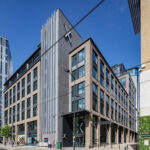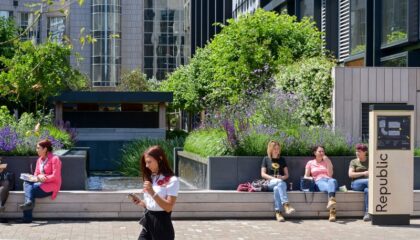What is retrofit?
(clue: it’s nothing new)
Retrofitting buildings is not a new concept; it’s been around for decades. As the realities of climate change manifest and deadlines for Net Zero loom into ever sharper focus, retrofitting is tipped as the key to unlock huge reductions in carbon emissions from the built environment.
Workman has project managed building retrofits for the past 40 years. But in today’s climate-challenged world, the reasons for retrofitting go far beyond simple aesthetic refurbishment. Today, the retrofitting process means improving a building to make it more energy efficient. This is while reducing embodied carbon emissions associated with development.
Two-thirds of the buildings that exist in the UK today will still be standing when the government’s 2050 Net Zero target rolls around. If this goal – along with commercial real estate investors’ energy saving and carbon targets – are to be met, significant energy efficiency and embodied carbon reductions are needed. To achieve these, swathes of the property sector will have to undergo some form of retrofit by 2050.
Since buildings account for as much as 70% of a city’s carbon emissions, the opportunity to make carbon savings by retrofitting existing real estate is vast.
How is a successful retrofit achieved?
Retrofit projects are not one-size-fits-all. Sometimes, particularly with older buildings, a whole-life carbon analysis may reveal that retrofitting isn’t the most efficient choice. Therefore, Workman is committed on the basis of retrofit-first, not retrofit-only.
From years of experience, our teams understand that retrofit measures should be considered once armed with information on economic and carbon payback, complexity and ease of implementation. This is all within the constraints of existing buildings.
While certain properties benefit from less invasive changes, like LED lighting, others need more extensive overhauls. Energy efficiency measures like new glazing, wall insulation, heat pumps, and solar panels play a crucial role in such cases.
Successfully retrofitting a building to reduce energy costs, lower carbon emissions, and enhance its commercial value is a complex undertaking. It requires forward planning and a long-term vision for the asset’s future.
Types of retrofit in focus
Global research carried out in 2022 by JLL, “Retrofitting Buildings to be Future-Fit” identified three types of retrofit:
- “Light” focuses on performance optimisation.
- “Mechanical, Electrical and Plumbing” involves deep retrofit of MEP equipment.
- “Whole” entails extensive building retrofit, delivering energy efficiency, emissions reduction, and energy bill savings.
Although every building is unique, retrofits can provide a cost-effective means to create sustainable office space, attractive for competitive rents. For example, in 2023 Venture, Workman’s Projects team, project-managed the deep retrofit of CBRE Investment Management’s 10 Brindleyplace (pictured below).
The scheme, which was formerly bank offices and flats, achieved an Energy Performance Certificate (EPC) A rating and BREEAM Excellent. It is now home to flexible office operator Spacemade, along with restaurant chain Turtle Bay.
- ©Ben McPhee / Associated Architects
Why is retrofit important now?
Market forces are pushing for greener buildings, with many lenders refusing to finance buildings at risk of obsolescence. Blue-chip tenants are unlikely to consider so-called “brown” space at any price, with concerns over carbon emissions and reputational damage. Conversely, properties with the highest environmental ratings and long term sustainability command a rental premium.
Indeed, London office buildings with top environmental credentials command a 25% premium, according to analysis by MSCI Inc. This gap is expected to widen, especially as occupants prioritise energy savings, carbon footprint reduction, and enhancing their sustainability credentials.
As the demand for Net Zero buildings continues to rise, there’s an opportunity for value uplift for those taking action. At the same time, there may be a potential “brown discount” for those who don’t.
The 2022 GRESB results – the accepted global ESG benchmark for real estate-related financial products – show that the average Carbon Risk Real Estate Monitor (CRREM) stranding year of GRESB-submitted buildings is 2025.
The British Property Federation (BPF) supports a retrofit-first approach, and is lobbying the government to “introduce an overarching retrofit strategy”. It has urged the government to regulate embodied carbon and has also called for planning reforms to prioritise the reuse of buildings, with a VAT exemption for refurbishment works.
Meanwhile, under the Minimum Energy Efficiency Standards (MEES), the EPC rating for commercial buildings is increasing to ‘B’ in 2030, so understanding the benefits of retrofitting assets on thermal performance and the direct link to rental value is crucial. However, EPCs are notional, and the importance of using real energy use and performance data, rather than modelling, has been widely recognised in the move towards low-carbon assets.
How can Workman help?
Driven by Net Zero targets, the momentum of capital towards “green” assets and away from “brown” appears unstoppable in the face of the flight from fossil fuels . However, in today’s economic climate, many investors are grappling with designing and financing schemes that are feasible, while also understanding the available technological solutions.
This is where Workman’s expertise proves invaluable. Our ESG Project Advisor service is specifically designed to assess the outcomes of retrofit moves, whether major or minor, at the outset of a project, so that potential energy consumption and carbon emissions savings can be factored in at the planning stages.









